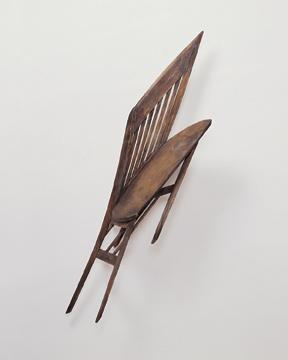Revelation
dal 2/6/2004 al 19/9/2004
Segnalato da
2/6/2004
Revelation
Mint Museum, Charlotte, NC
A Fresh Look at Contemporary Collections. Revelation presents artworks spanning the past four decades from minimalist statements of the 1960s and 1970s; encompassing popular culture-inspired art of the 1970s and 1980s; to recent works that address environmental issues and the quests for identity.

A Fresh Look at Contemporary Collections
May 29 - September 19, 2004
This summer's exhibition reexamines selections from The Mint Museums'contemporary collection. Works from the Mint's permanent collection, which have never been exhibited have been sprung from storage, new acquisitions are being unveiled, and other works have been generously made available by collectors revealing a vibrant interest in the art of our time.
Revelation: A Fresh Look at Contemporary Collections - on display May 29 through September 19, at the Mint Museum of Art - addresses relevant themes and trends from the 1960s onward via 60 contemporary paintings, sculptures, photographs and works on paper.
Revelation presents artworks spanning the past four decades from minimalist statements of the 1960s and 1970s; encompassing popular culture-inspired art of the 1970s and 1980s; to recent works that address environmental issues and the quests for identity.
The freedom from prescribed methods of creating art had its genesis in the 1960s, a time of vast social change. Artists began to question how art should (or should not) function: whether it should be accessible to everyone or only to an elite few. The formal concerns of modern painters of the 1950s-their emphasis on the essential qualities of color and flatness-gave way to several important investigations: the spare statements of minimalist works that often incorporated grid patterning or machine-forged components; the exploration of how the eye physiologically registers color and perception investigated by practitioners of op art; and the influence of popular culture (media and advertising) on the wealth of material imagery found in pop art.
In diametric contrast to the concerns of the minimalists and op artists were the explorations of a new generation of artists who drew upon images found in popular culture.
Popular culture-inspired artwork served to redefine expectations about the function of art, allowing it to provide commentary about the contemporary experience. This intent to reflect the experiences and perceptions of modern life remains one of the most salient themes probed by contemporary artists. The media-influenced art of the 1960s and 1970s served as the precursor to 1980s and 1990s postmodernism, in which issues of personal, racial and gender identity were examined by artists and the works they created. From the 1960s onward, photography continued to be a viable source for artists as they composed and directed the images captured on film to make particular statements about malleable identity. The landscape also became relevant subject matter for environmentally conscious artists, conveying a sort of ''ecological revolt'' - exploring the symbiotic / reciprocal relationship we have with the external, natural environment.
New approaches to methods and materials were another major development from the 1970s onward. Artists began using a variety of unorthodox materials, such as Petah Coyne's use of earth and sticks to create a suspended sculpture which resembles a habitat, or Donald Sultan's use of tar, flooring material and flocking to create a painting.
Chuck Close, Alex Katz and Amy Fichter all create frontal portraits, although their techniques of rendering friends and relatives vary drastically.
Judy Fox is perhaps best known for her series of hyper-realistic ceramic portraits. Einstein is one of many portraits in which Fox illuminates the childhood innocence of the world's great minds. Balancing precariously on one foot as if challenging the Newtonian laws of gravity, the infant Einstein teeters at the edge of the high pedestal. Einstein's theory of General Relativity, published in 1915, proposed that both gravity and motion can affect the intervals of time and space.
Robert Lazzarini's sculptures also investigate hyper-realism, but his use of distorted perspective lends a new interpretation of familiar objects, such as a violin, chair or hammer. Fabricated with amazing veracity, yet extremely distorted, these ubiquitous objects take on an expressive quality that is at once haunting and iconic. Like their minimalist antecedents, Lazzarini's sculptures are experienced in real time and space.
Collectively, the variety of works presented in this exhibition illuminates the multiple perspectives gained by experiencing the world viscerally and with great curiosity. In the hands of these artists, form and material are altered to reflect concepts, to make tangible thought. With great sensitivity, the artists bring to their work an awareness of the mystery of both the physical and inner realms, reveling in both the unnerving as well as the enchanting.
Mint Museum of Art, Charlotte, NC USA



